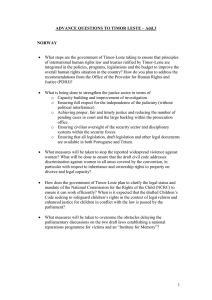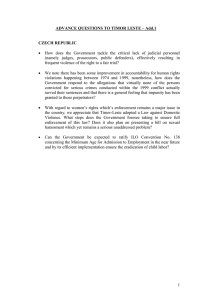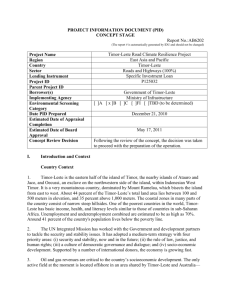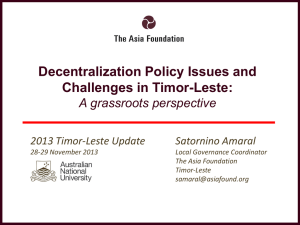Current and future climate of Timor-Leste
advertisement
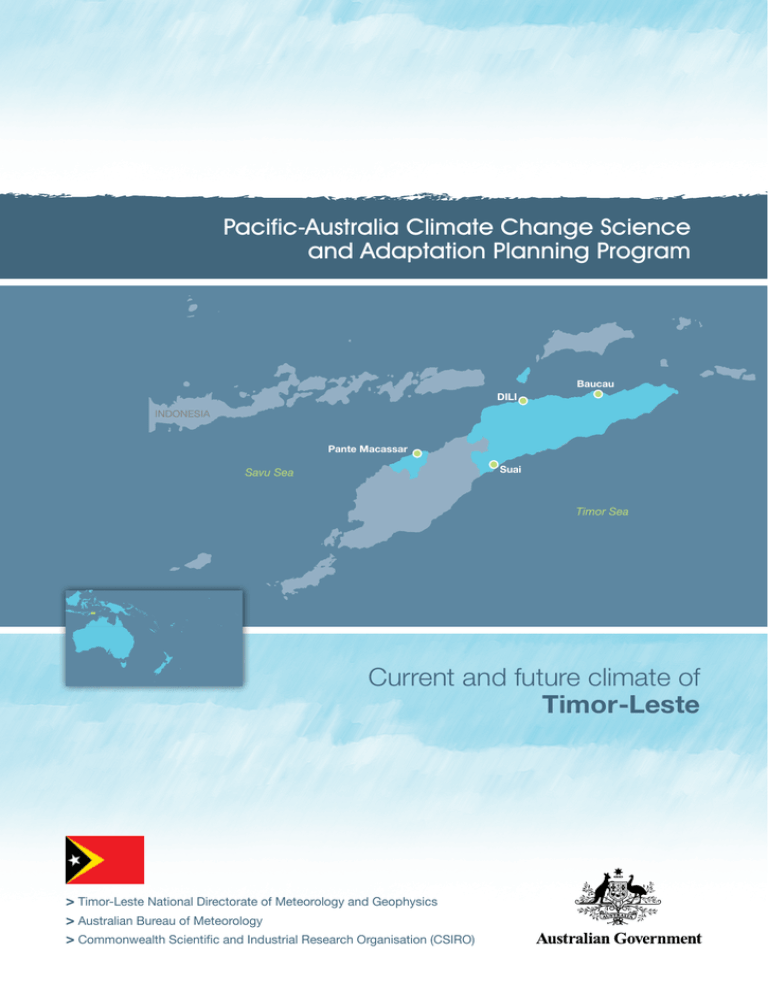
Pacific-Australia Climate Change Science and Adaptation Planning Program Baucau DILI INDONESIA Pante Macassar Suai Savu Sea Timor Sea Current and future climate of Timor-Leste > Timor-Leste National Directorate of Meteorology and Geophysics > Australian Bureau of Meteorology > Commonwealth Scientific and Industrial Research Organisation (CSIRO) Timor-Leste’s current climate Temperature West Pacific Monsoon Year-to-year variability In Dili the temperatures in the warmest months (October to May, Figure 1) are about 2.5ºC warmer than those in July, the coldest month. Temperature is strongly tied to changes in the surrounding ocean temperature. Timor-Leste’s climate is affected by the West Pacific Monsoon (Figure 2), which is driven by large differences in temperature between the land and the ocean. It moves north to mainland Asia during the Southern Hemisphere winter and south to Australia in the Southern Hemisphere summer. Its seasonal arrival usually brings a switch from very dry to very wet conditions. The normal south-easterly trade winds in Dili are replaced by westerly winds from the monsoon onset until the end of the monsoon season. Year-to-year variations in Timor-Leste’s climate are due to the El Niño–Southern Oscillation and the Indian Ocean Dipole. The El Niño–Southern Oscillation is a natural climate pattern that occurs across the tropical Pacific Ocean and affects weather around the world. There are two extreme phases of the El Niño–Southern Oscillation: El Niño and La Niña. There is also a neutral phase. El Niño events generally bring drier conditions to Dili, and often lead to a late onset and early finish to the wet season. During La Niña events, dry season rainfall tends to be above normal, and the wet season often starts earlier and finishes later. The Indian Ocean Dipole is a climate pattern that affects weather around the Indian Ocean basin. During a positive phase of the Indian Ocean Dipole dry season rainfall in Dili is lower than normal. Rainfall Dili has a very marked wet season from December to May and a dry season from June to November. For most of the wet season average monthly rainfall is above 100 mm per month while for most of the dry season it is less than 30 mm per month. Floods and droughts During La Niña years above-normal rainfall leads to increased flooding and landslides in Timor-Leste, while El Niño years are associated with droughts. The most significant impact on the population during El Niño years is reduced ground water availability. Tropical cyclones Figure 1: Seasonal rainfall and temperature at Dili. Air temperature records for Dili are not long enough to calculate an accurate climatology. Instead annual variations in sea-surface temperatures, which are likely to be closely related to air temperatures, have been used to show the seasonal temperature cycle. 2 Current and future climate of Timor-Leste | Current climate Tropical cyclones can affect TimorLeste between November and April, however their effect tends to be weak due to proximity to the equator. In the 42-year period between the 1969 and 2010 seasons, seven tropical cyclones developed within or passed through the Timor-Leste Exclusive Economic Zone, all of which were less than Category 3. Figure 2: Average positions of the major climate features in November to April. The arrows show near surface winds, the blue shading represents the bands of rainfall convergence zones, the dashed oval shows the West Pacific Warm Pool and H represents typical positions of moving high pressure systems. Wind-driven waves The wind-wave climate of Timor-Leste is strongly characterised by the West Pacific Monsoon winds in December to March and south-easterly trade winds in June to September. Wind-waves around Timor-Leste are quite small, typically less than one metre high. At Dili on the north coast, slightly larger than average waves are directed from the east-northeast during June to September (Figure 3). During December to March slightly smaller than average waves from monsoon systems are directed from the north-west and west. Wave power varies from year to year but is strongest during La Niña years over the wet season, associated with an increase in monsoon winds. 3 Figure 3: Annual cycle of wave height (grey) and wave direction (blue) at Dili based on data from 1979–2009. The shaded boxes represent one standard deviation around the monthly means, and the error bars indicate the 5–95% range, showing the year-to-year variability in wave climate. The direction from which the waves are travelling is shown (not the direction towards which they are travelling). Current and future climate of Timor-Leste | Current climate Timor-Leste’s changing climate Temperatures and rainfall may be changing Despite missing temperature records for Dili Airport, it is probable that there has been a warming air temperature trend here over the past half-century, in line with regional and global trends. This warming is partly due to the warming ocean temperatures around Timor-Leste. The observed rainfall records for Dili Airport do not show any significant trends in annual or halfyear rainfall (Figure 4). The influence of the El Niño-Southern Oscillation is evident in the large year-to-year variability of the rainfall totals. Sea level has risen As ocean water warms it expands causing the sea level to rise. The melting of glaciers and ice sheets also contributes to sea-level rise. Instruments mounted on satellites and tide gauges are used to measure sea level. Satellite data indicate the sea level has risen near Timor-Leste by about 9 mm per year since 1993 (Figure 5). This is larger than the global average of 2.8–3.6 mm per year. This higher rate of rise may be partly related to natural fluctuations that take place year to year or decade to decade caused by phenomena such as the El Niño-Southern Oscillation. Figure 4: Annual average values of total rainfall at Dili Airport. Light blue, dark blue and grey bars indicate El Niño, La Niña and neutral years respectively. Missing bars indicate no data is available. The solid black line shows the trend. 4 Current and future climate of Timor-Leste | Changing climate Ocean acidification has been increasing About one quarter of the carbon dioxide emitted from human activities each year is absorbed by the oceans. As the extra carbon dioxide reacts with sea water it causes the ocean to become slightly more acidic. This impacts the growth of corals and organisms that construct their skeletons from carbonate minerals. These species are critical to the balance of tropical reef ecosystems. Data show that since the 18th century the level of ocean acidification has been slowly increasing in Timor-Leste’s waters. Fishing off Dili coast. Timor-Leste’s future climate Climate impacts almost all aspects of life in Timor-Leste. Understanding the possible future climate of Timor-Leste is important so people and the government can plan for changes. At a glance • El Niño and La Niña events will continue to occur in the future, but there is little consensus on whether these events will change in intensity or frequency. • Annual mean temperatures and extremely high daily temperatures will continue to rise. • There is a range of projections of average annual rainfall, from a decrease to increase, but with more extreme rain events. • Drought frequency is projected to remain similar to the current climate. • Sea level will continue to rise. • Ocean acidification is expected to continue. • The risk of coral bleaching is expected to increase. • A reduction of wave period in January is projected. Monsoon season conditions, Dili. 5 Current and future climate of Timor-Leste | Future climate Temperatures will increase Changing rainfall patterns More very hot days Projections for all emissions scenarios indicate that the annual average air temperature and sea-surface temperature will increase in the future in Timor-Leste (Table 1). By 2030, under a very high emissions scenario, this increase in temperature is projected to be in the range of 0.5–1.1°C. Later in the century the range of the projected temperature increase under the different scenarios broadens. There is uncertainty around rainfall projections as model results are not consistent. Projections generally suggest that long-term rainfall over Timor-Leste will remain similar to the current climate. Wet and dry years will still occur in response to natural variability. Rainfall associated with the West Pacific Monsoon is projected to generally increase. Little change is projected in the frequency of droughts throughout this century. Increases in average temperatures will also result in a rise in the number of hot days and warm nights, and a decline in cooler weather. More extreme rainfall days Projections show extreme rainfall days are likely to occur more often. Table 1: Projected changes in the annual average surface air temperature for Timor-Leste. Values represent the 90% of the range of the models and are relative to the period 1986–2005. 2030205020702090 (°C) (°C) (°C) (°C) Very low emissions scenario 0.4 –0.8 0.5–1.1 0.4–1.1 0.4–1.2 Low emissions scenario 0.4–1.0 0.8 –1.5 0.9–1.9 1.1–2.1 Medium emissions scenario 0.4 –1.0 0.7–1.5 1.1–1.9 1.5–2.6 Very high emissions scenario 0.5 –1.1 1.0–2.0 1.7–3.1 4.0–4.2 Flooding, Dili 2011. Taking temperature observations, National Directorate of Meteorology and Geophysics. 6 Current and future climate of Timor-Leste | Future climate Sea level will continue to rise Sea level is expected to continue to rise in Timor-Leste (Table 2 and Figure 5). By 2030, under a very high emissions scenario, this rise in sea level is projected to be in the range of 9–18 cm. The sea-level rise combined with natural year-to-year changes will accentuate the impact of storm surges and coastal flooding. As there is still much to learn, particularly how large ice sheets such as Antarctica and Greenland contribute to sea-level rise, scientists warn larger rises than currently predicted could be possible. Figure 5: Tide‑gauge records of relative sea level (since the late 1970s) are indicated in purple, and the satellite record (since 1993) in green. The reconstructed sea-level data at Timor-Leste (since 1950) is shown in black. Multi-model mean projections from 1995–2100 are given for the very high (red solid line) and very low emissions scenarios (blue solid line), with the 5–95% uncertainty range shown by the red and blue shaded regions. The ranges of projections for the four emissions scenarios by 2100 are also shown by the bars on the right. The dashed lines are an estimate of year-to-year variability in sea level (5–95% uncertainty range about the projections) and indicate that individual monthly averages of sea level can be above or below longer‑term averages. Table 2: Projected changes in the annual mean sea level rise (in cm) for Timor-Leste. Values represent the 90% of the range of the model results and are relative to the period 1986–2005. 2030205020702090 (cm) (cm) (cm) (cm) Very low emissions scenario 8–17 15–30 21–45 26–59 Low emissions scenario 9–17 16–31 24–48 32–67 Medium emissions scenario 8–17 15–30 23–47 33–68 Very high emissions scenario 9–18 18–34 30–58 43–88 Timor-Leste Very high Medium Low Very low Ocean acidification will continue Little change in wave climate Under all four emissions scenarios the acidity level of sea waters in the Timor-Leste region will continue to increase over the 21st century, with the greatest change under the very high emissions scenario. The impact of increased acidification on the health of reef ecosystems is likely to be compounded by other stressors including coral bleaching, storm damage and fishing pressure. The wind-wave climate of Timor-Leste is projected to show little change by the end of the century. Some models suggest a slight decrease in wave period during January and an overall decrease in the height of large waves, however there is large year-to-year variability. 7 Current and future climate of Timor-Leste | Future climate How do scientists develop climate projections? Global climate models are the best tools for understanding future climate change. Climate models are mathematical representations of the climate system that require very powerful computers. They are based on the laws of physics and include information about the atmosphere, ocean, land and ice. There are many different global climate models and they all represent the climate slightly differently. Scientists from the Pacific-Australia Climate Change Science and Adaptation Planning Program have evaluated models from around the world and found that 26 best represent the climate of the Timor-Leste region of the western tropical Pacific. These 26 models have been used to develop climate projections for Timor-Leste. emissions scenarios are used in climate modelling to provide projections that represent a range of possible futures. The Intergovernmental Panel on Climate Change (IPCC) developed four greenhouse gas and emissions scenarios, called Representative Concentration Pathways (RCPs). These scenarios cover a broad range of possibilities. For example, the lowest scenario shows the likely outcome if global emissions are significantly reduced, while the highest scenario shows the impact of a pathway with no policy of reducing emissions. The climate projections for TimorLeste are based on the four IPCC emissions scenarios: very low (RCP2.6), low (RCP4.5), medium (RCP6.0) and very high (RCP8.5), for 20-year time periods centred on 2030, 2050, 2070 and 2090, relative to a 20year time period centred on 1995 (Figure 6). Since individual models give different results, the projections are presented as a range of values. When interpreting projected changes in the mean climate in the Pacific, it is important to keep in mind that natural climate variability, such as the state of the El Niño-Southern Oscillation, strongly affects the climate from one year to the next. The future climate will be determined by a combination of natural and human factors. As we do not know what the future holds, we need to consider a range of possible future conditions, or scenarios, in climate models. Greenhouse gas and aerosol Figure 6: Carbon dioxide concentrations (parts per million, ppm) associated with the very low (RCP2.6), low (RCP4.5), medium (RCP6.0) and very high (RCP8.5) emissions scenarios for 20-year time periods (shaded) centred on 1995 (the reference period), 2030, 2050, 2070 and 2090. This brochure contains a summary of climate projections for Timor-Leste. For more information refer to the technical reports Climate Change in the Pacific: Scientific Assessment and New Research (Volume 2) and Climate Variability, Extremes and Change in the Western Tropical Pacific: New Science and Updated Country Reports. These reports are available at www.pacificclimatechangescience.org. Climate projections are also available through the web-based Pacific Climate Futures tool at www.pacificclimatefutures.net. 8 Current and future climate of Timor-Leste | Future climate Changes in Timor-Leste’s climate > Temperatures have warmed and will continue to warm with more very hot days in the future. > There are no clear trends in annual rainfall totals for Dili Airport, and there are a range of rainfall projections. There will be more extreme rainfall days. Drought frequency is projected to remain similar to the current climate. > Sea level near Timor- > Ocean acidification Leste has risen and will continue to rise throughout this century. This publication updates the original Current and future climate of Timor-Leste brochure published in 2011. The content of this brochure is the result of a collaborative effort between the Timor-Leste National Directorate of Meteorology and Geophysics and the Pacific-Australia Climate Change Science and Adaptation Planning (PACCSAP) Program – a component of the Australian Government’s International Climate Change Adaptation Initiative. The information in this publication and research conducted by PACCSAP builds on the findings of the 2013 IPCC Fifth Assessment Report, and uses new emissions scenarios and climate models. For more detailed information on the climate of Timor-Leste and the Pacific see Climate Variability, Extremes and Change in the Western Tropical Pacific: New Science and Updated Country Reports (2014) and Climate Change in the Pacific: Scientific Assessment and New Research. Volume 1: Regional Overview. Volume 2: Country Reports (2011). www.pacificclimatechangescience.org has been increasing in Timor-Leste’s waters. It will continue to increase and threaten coral reef ecosystems. > Wave climate is projected to remain similar to the current climate with a reduction in wave period during January. Contact the Timor-Leste National Directorate of Meteorology and Geophysics: web: www.dnmg.gov.tl email: dnmg.fst@gmail.com phone: +670 3331092 ©2 015 Pacific-Australia Climate Change Science and Adaptation Planning Program partners
